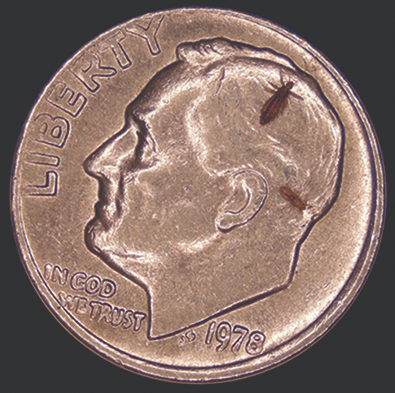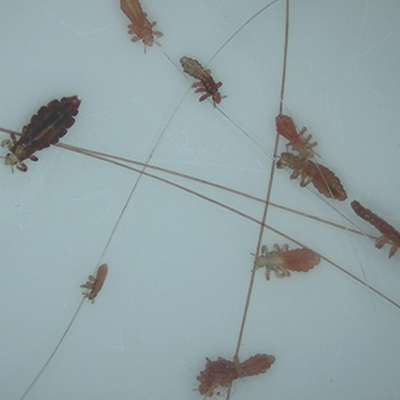Lice Facts
EVERYTHING YOU’VE EVER WANTED TO KNOW ABOUT HEAD LICE
Between 6 and 12 million children are infested with head lice in the US each year according to the FDA. Very often parents contract head lice from their children.

LICE
Although there are many types of lice, the head louse, or Pediculus humanus capitis, is a parasitic insect that can be found on the head and, more rarely, the eyebrows and eyelashes of people. Head lice (the plural form of louse) feed on human blood several times a day and live close to the scalp to maintain their body temperature.
LIFE CYCLE
Head lice come in three stages: egg, nymph and adult (learn how big lice are in their various stages). Eggs are often called lice nits, although many people refer to nits as the empty egg shells left behind by a hatched louse.

LICE HAVE CLAWS
A head louse has six claws that allow it to crawl around from hair strand to hair strand. It can move from one head to another this way, which is why head-to-head contact is the primary way head lice are spread between people.
HEAD TO HEAD
A head-lice infestation occurs when a female adult louse makes it onto a new head and lays eggs. When those eggs hatch, the lice will most likely stay on that head throughout the entire lice life cycle. Unless the head is treated (see pediculosis treatment) and all lice and eggs are eradicated, the lice infestation will continue for however long the lice can live.
Frequently Asked Questions
Do I have lice?
Adult lice will be the easiest to spot because they are the biggest. But at the size of a sesame seed, they still aren’t that big. Although lice vary in color, if you see a grayish-white or tan bug crawling through the hair, it is probably a louse. If you look closely at an adult louse, you should be able to see human blood inside it.
Look at the hair strands about a quarter inch (~0.5 cm) off the scalp. See if you can find lice eggs (often called nits) attached to individual hairs. Nits are extremely small. They look like tiny specks and will be glued pretty securely to the hair. If you see any, try pulling them off with your fingers. If you can’t easily pull them off, they are probably eggs and not dandruff.
How can I get lice?
The primary way you can get head lice is when your head comes in direct contact with the head of an infested individual. Head-to-head contact like that doesn’t guarantee that the infestation will spread, but it gives lice the best opportunity to move from the hair of the infested person to your hair.
Head lice don’t jump, swim or fly. Without strands of hair to grab with the claws on their legs, they have trouble getting around at all. However, they can crawl pretty quickly along the hair, so if your hair comes in contact with an infested head, it doesn’t take much for a louse to hitch a ride on a strand of your hair and make its way to your scalp.
How long can lice live?
Excluding the 8-9 days they spend as eggs, head lice can live for around 40-45 days on your head. As parasites, they feed on human blood several times a day.
If they are removed from their food source – say from getting knocked out of your hair with a brush or your hand – they can survive 24-48 hours. If they don’t find some human hair to crawl back to a new host during that time, they will die.
How can I kill lice?
There are many ways you can kill lice. You can suffocate them, poison them, or dry them out. You can also starve them if you get them away from their food source – your head – long enough (they’ll die within 24-48 hours).
What should I do after treatment
Head lice do not survive long if they fall off a person and cannot feed. You don’t need to spend a lot of time or money on housecleaning activities. Follow these steps to help avoid re–infestation by lice that have recently fallen off the hair or crawled onto clothing or furniture.
Machine wash and dry clothing, bed linens, and other items that the infested person wore or used during the 2 days before treatment using the hot water (130°F) laundry cycle and the high heat drying cycle. Clothing and items that are not washable can be dry–cleaned OR sealed in a plastic bag and stored for 2 days.
Soak combs and brushes in hot water (at least 130°F) for 5–10 minutes.
Vacuum the floor and furniture, particularly where the infested person sat or lay. However, the risk of getting infested by a louse that has fallen onto a rug or carpet or furniture is very small. Head lice survive less than a day if they fall off a person and cannot feed; nits cannot hatch and usually die within a week if they are not kept at the same temperature as that found close to the human scalp. Spending much time and money on housecleaning activities is not necessary to avoid re-infestation by lice or nits that may have fallen off the head or crawled onto furniture or clothing.
Do not use fumigant sprays; they can be toxic if inhaled or absorbed through the skin.
Does insurance cover treatment?
Lice removal services are covered by many insurance companies as well as health and flex spending accounts. We provide the necessary paperwork to help you file your insurance claim and we can also provide you with a physician referral form, if needed.
Please contact your insurance company to determine coverage, as we Do Not Accept Insurance. We do accept FSA and HSA credit cards in all of our clinics.
